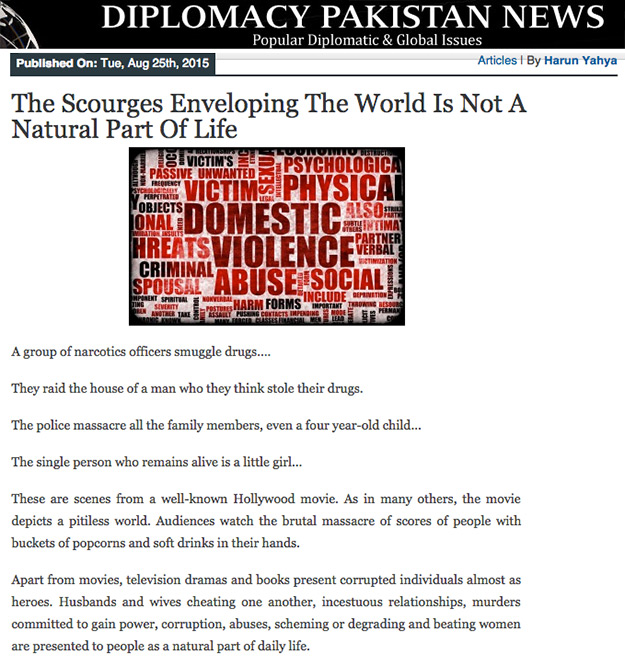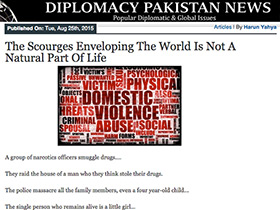
A group of narcotics officers smuggle drugs….
They raid the house of a man who they think stole their drugs.
The police massacre all the family members, even a four year-old child…
The single person who remains alive is a little girl…
These are scenes from a well-known Hollywood movie. As in many others, the movie depicts a pitiless world. Audiences watch the brutal massacre of scores of people with buckets of popcorns and soft drinks in their hands.
Apart from movies, television dramas and books present corrupted individuals almost as heroes. Husbands and wives cheating one another, incestuous relationships, murders committed to gain power, corruption, abuses, scheming or degrading and beating women are presented to people as a natural part of daily life.
We generally think they are stories copied from real life, and in some cases, they certainly are. However many social scientists and psychologists think otherwise and remark that the elements of exaggerated violence used in the media have a decidedly negative impact on societies.
Medaim Yanık, an Associate Professor in Mental Facility, makes the following remark:
“Media makes an impact on how violence is being perceived… Excessive visualizing of violence may facilitate other violent acts. There are some ethical standards while reporting news about violence. But complying with these laws generally is incompatible with the competitive style of modern journalism.” (1)
Now let’s provide some evidence about the accuracy of this evaluation:
Until he grows into an adult, a child witnesses thousands of scenes of violence by means of movies or news reports. In very few of these murders, there are scenes about the remorse of the perpetrator or the pangs of conscience he suffers. Under the impact of what he watches, even though he kills someone, a child is encouraged to think that life would go on as normal in jail, perhaps as though he were in a boarding school. The powerful impact of such negative examples causes the raising of individuals who consider violence as normal.
People whose childhoods are spent watching movies and playing computer games instilling murder, fighting and violence can consider murder very reasonable. American Lieutenant Chad’s words are a solid example: He said that after one hour he made the airstrike, he was in Las Vegas (3). This scary and weird attitude is surely not peculiar to the Lieutenant Chad only. Just a day after the Lieutenant made the airstrike, a news report stating that 12 civilians who were returning from a wedding were shot dead in a drone attack against Al-Qaeda militants in Yemen (4) probably did not receive much attention from the readers.
In fact this is a spiral of violence: Someone generates fiction-legitimizing killings. Everyday these fictions are being constantly instilled in people via newspapers and televisions.
With these pretexts such as war on terror, in many cases, orders are given to kill innocent people. The party on one side of this spiral of violence is people like Lieutenant Chad who follow these orders. The other party is those societies who are benumbed and who get used to it.
It is surely possible to break this startling spiral of violence, which creates injustice, hostility, abuse and all kinds of other wickedness.
Rather than focusing on ratings and making money and thus triggering or encouraging wickedness, the media can generate content to restrain and eliminate degeneracy. Assoc. Prof Aydan Ozsoy from the Gazi University Communication Faculty of Radio and Television is one of the academicians who share this opinion. Mrs. Ozsoy explains the kind of responsibility the media must assume in social issues as thus:
“It is obvious that there are many reasons for the increase in violence and murder in societies. Rather than triggering violence in favor of ratings and making money, media can generate content to curb it. Every awareness that can be created in society is important. Especially when we think the impact the heroes of Turkish soap operas have on society, these heroes can assume an important role in creating this awareness.” (5)
The media can assume an educational role by using movie heroes with whom people identify themselves. To this end, decent heroes who do not struggle against wickedness by employing violence as their main resort, or those who feel remorse for their crimes can be presented. It can be emphasized that a world where disagreements and conflict among people and iniquity can be put to right would be secure, prosperous and reliable. Encouraging cooperation, unity, solidarity, love and compassion is not naivety and the harm of conducting oneself in line with self-absorbed motives can be discussed by celebrities during primetime. Social media can put this issue on the agenda. School textbooks can illustrate that violence is not a solution and the harm it causes to both individuals and society can be explained by statistical information and with appropriate examples.
In such a world where the spiral of violence is broken, kids will be able to play in the streets and women will be able to walk even in the darkest streets without any fear. The billions of dollars spent on weapons and means of individual defense would be used for the benefit of humanity. War, hardship, starvation, poverty and ignorance will no longer trouble people. This is not a dream or an utopia; this can be accomplished very easily. It is only a matter of good people being united against evil.
References:
- http://www.anlayis.net/makaleGoster.aspx?dergiid=74&makaleid=2073
- http://www.usasabah.com/Guncel/2013/03/16/iste-irak-isgalinin-faturasi
- http://www.hurriyet.com.tr/yazarlar/21085842.asp
- http://www.democracynow.org/2014/2/21/turning_a_wedding_into_a_funeral
- http://www.aljazeera.com.tr/gorus/yerli-dizilerin-urettigi-siddet-cinsiyetcilik-ve-kadin-cinayetleri
Adnan Oktar's piece on Diplomacy Pakistan:
http://www.diplomacypakistan.com/articles/the-scourges-enveloping-the-world-is-not-a-natural-part-of-life/


